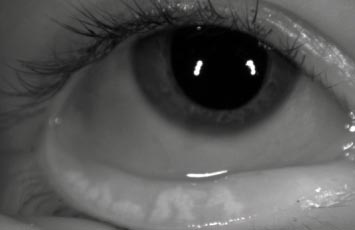 |
| Many patients with seasonal allergic conjunctivitis have clinical signs of tear instability and meibomian gland distortion. Photo: Kambiz Silani, OD. Click image to enlarge. |
Of all cases of allergic conjunctivitis, 90% are of the seasonal subtype. Because the meibomian gland plays such an important role in keeping the tear film stable and preventing harm to the ocular surface, researchers recently conducted a study to determine how this structure is affected in patients with seasonal allergic conjunctivitis. They found that compared with controls, those with seasonal allergic conjunctivitis had more significant morphological and cytological changes in the meibomian gland.
The study observed 89 eyes from 89 patients diagnosed with seasonal allergic conjunctivitis along with 112 healthy volunteers. The OSDI questionnaire was used to evaluate symptoms, and the following tests were performed on each patient: tear evaporation rate from the ocular surface, slit lamp exam, tear film breakup time, Schirmer test, vital staining, meibography and meibum expression grading.
Scores on the OSDI questionnaire were higher in the seasonal allergic conjunctivitis group than in the control group. According to the responses, 92.1% of patients had tear film instability compared with 29% of controls. Nearly every parameter of meibomian gland function and ocular surface health measured during the clinical exam was worse in patients than in controls, including tear evaporation rate from the ocular surface, breakup time, vital staining, meibomian gland expression, meibomian gland distortion rate and meibomian gland dropout grade. When the research team used laser scanning confocal microscopy to examine participants’ meibomian glands, the findings also confirmed that seasonal allergic conjunctivitis patients had significantly worse average parameters compared with healthy controls.
“Our results showed that 60.7% of the seasonal allergic conjunctivitis patients had meibomian gland dropout compared with 26.8% among the normal controls,” the researchers wrote in their study. “These results suggest that the symptom of xerophthalmia (instability of the tear film) among seasonal allergic conjunctivitis patients might be due to the changed tear film lipid layer, and this is possibly related to meibomian gland distortion, meibomian gland dropout and changed meibomian gland orifices.”
This study, along with previous ones, has demonstrated that a large portion of seasonal allergic conjunctivitis patients exhibit meibomian gland alterations. However, the underlying mechanisms of these changes are not yet known. “Some hypotheses have been proposed, like meibomian gland infiltration by lymphocytes and meibomian gland ductal epithelial hyperkeratinization and, more recently, the inflammatory damages to the cornea and conjunctiva,” the researchers noted. Further research may help to better understand why this patient subset is more prone to these morphological changes.
Liu L, Yang J, Ji W, Wang C. Assessment of meibomian gland impairment among seasonal allergic conjunctivitis patients. Med Sci Monit. April 5, 2022. [Epub ahead of print]. |

